Ahsan A. (ed.) Evaporation, Condensation and Heat transfer
Подождите немного. Документ загружается.

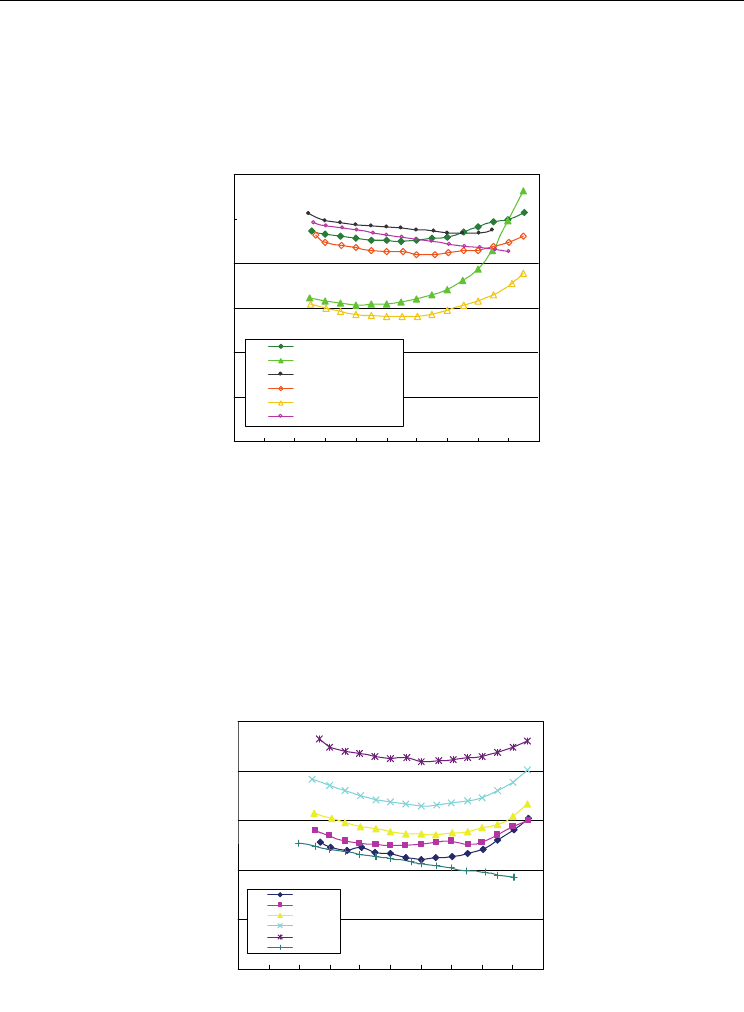
High-Carbon Alcohol Aqueous Solutions and
Their Application to Flow Boiling in Various Mini-Tube Systems
469
increase with increasing temperature. This is attributed to the elimination of the escaping
vapour in the maximum bubble pressure method. The effect of the escaping vapour on the
alcohol concentration in Wilhelmy’s method, which was employed in the previous study
(Ono et al., 2009), was not negligible, and the maximum bubble pressure method used in
this study successfully prevented this problem. The authors believe that more reliable data
were obtained in this study.
0
10
20
30
40
50
60
0 102030405060708090100
Temp erature[
℃
]
Surface tension[mN/m]
butanol_1.5wt%[wilhelmy]
pentanol_1.5wt%[wilhelmy]
ethanol_7 .15 wt%[wilhelmy]
butanol_1.5wt%[bubble]
pentanol_1.5wt%[bubble]
ethanol_7.15wt%[bubble]
Fig. 5. Comparison of the maximum bubble pressure method and Wilhelmy’s method for
various solutions.
Figure 6 shows measured results for butanol aqueous solutions. As the temperature
increased, the surface tension of most butanol solutions decreased up to approximately 60
°C. Above 60 °C, the surface tension started to increase. At higher concentrations, the
absolute value of surface tension was lower, and the nonlinearity was greater. Figure 6
includes results for pure butanol, which is referred to as butanol. As expected, the surface
tension of butanol decreased monotonically, as it was heated. This tendency differs
significantly from that of alcohol aqueous solutions.
0
10
20
30
40
50
0 102030405060708090100
Temp erature[
℃
]
Surface tension[mN/m]
7.15wt%
6.0wt%
4.5wt%
3.0wt%
1.5wt%
butnol
Fig. 6. Surface tension of butanol aqueous solutions measured by the maximum bubble
pressure method.
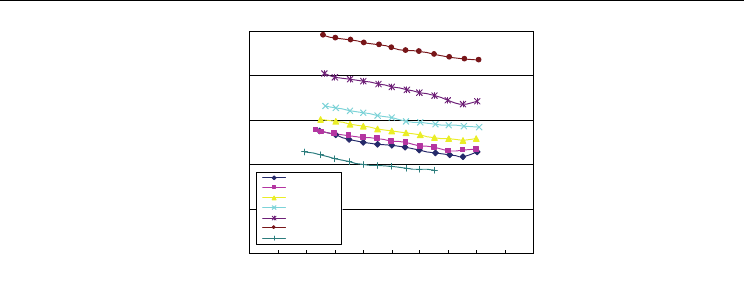
Evaporation, Condensation and Heat Transfer
470
0
10
20
30
40
50
0 102030405060708090100
Temp erature[
℃
]
Surface tension[mN/m]
ethanol_55.0wt%
ethanol_45.0wt%
ethanol_35.0wt%
ethanol_25.0wt%
ethanol_15.0wt%
ethanol_7.15wt%
ethanol
Fig. 7. Surface tension of ethanol aqueous solutions measured by the maximum bubble
pressure method.
Figure 7 shows results for ethanol aqueous solutions. All lines tend to decrease
monotonically as the temperature increases. However, surface tension remained constant
and increased slightly at temperatures above 75 °C. The authors believe that this could be
the result of instability caused by boiling because the boiling point of these solutions is
approximately 80 °C.
The maximum bubble pressure method found a milder nonlinearity for the surface tension
of butanol and pentanol aqueous solutions than Wilhelmy’s method, as shown in Fig. 5. The
authors believe that because the maximum bubble pressure method encloses the test fluid
and the vapour, the error caused by changes in concentration because of species evaporation
was greatly minimized. This condition is very different from that employed in Wilhelmy’s
method. The authors consider the maximum bubble pressure method and procedure used in
this study gave more reasonable and reliable values.
The solubility of butanol in pure water at room temperature is 7.15 wt% and that of
pentanol in pure water at room temperature is 2.0 wt%. The surface tension of pure water is
very sensitive to the addition of these alcohols. At solubility concentrations, the surface
tension of alcohol aqueous solutions approached that of pure alcohols at low temperature,
as shown in Fig. 6.
On the other hand, the ethanol aqueous solutions varied in their temperature dependence,
as shown in Fig. 7. The solubility concentration is not 55 wt%. If the concentration of ethanol
was increased further, the line would approach that of pure ethanol.
In summary, by performing these measurements, the authors themselves re-confirmed the
peculiar dependence of surface tension on temperature in high-carbon alcohol aqueous
solutions. The nonlinearity of the behaviour was milder than that expected from
measurements using the traditional Wilhelmy’s method. The maximum bubble pressure
method yielded very reasonable data. The authors then began flow boiling experiments
with those peculiar solutions and attempted to determine their advantages in terms of heat
transfer enhancement.
3. Simple application to flow boiling in a straight mini tube
As a simple application of the peculiar solutions, the authors attempted flow boiling
experiments in a single straight tube made of quartz and applied a high-carbon alcohol
aqueous solution as the working fluid (Ono et al., 2008a). Figure 8(a) shows the flow loop used
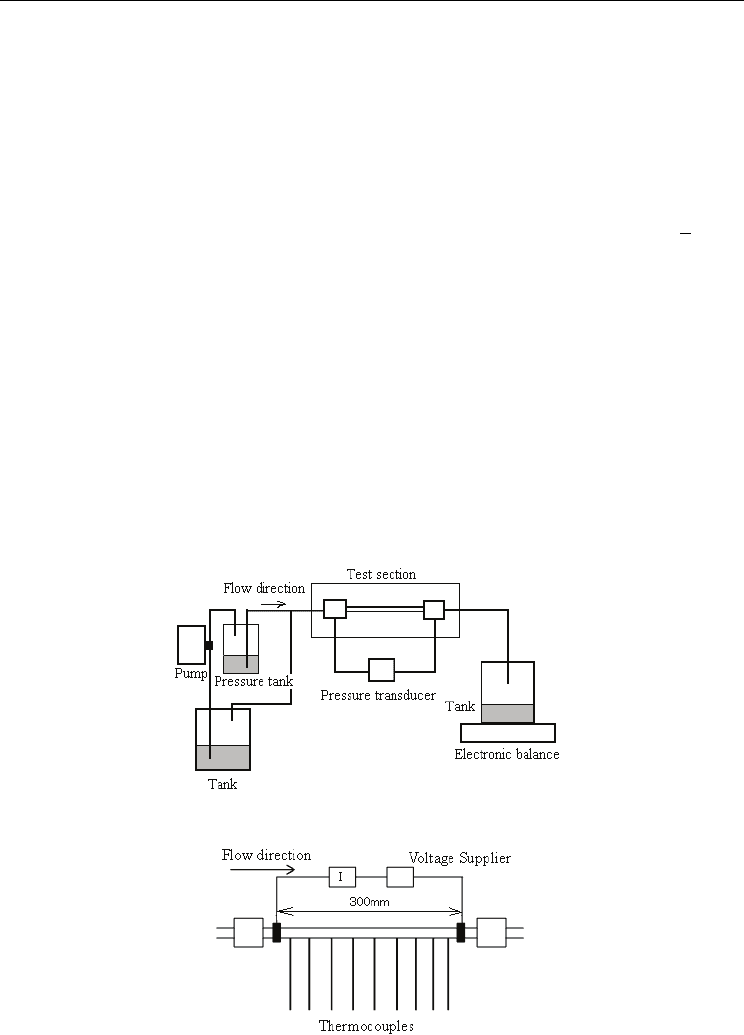
High-Carbon Alcohol Aqueous Solutions and
Their Application to Flow Boiling in Various Mini-Tube Systems
471
in the experimental examination of convective boiling in the mini tube. A diaphragm pump
was used to supply the fluid at a mass flux of 1–2 kg/m
2
s. A pressure tank was properly
installed to eliminate the pressure beat caused by the pump. Figure 8(b) shows the test section
in the experiment. A quartz glass tube was used as the test section. The tube was 1.0 mm in ID
and 2.0 mm in OD. To provide Joule heating, a mixture of indium tin oxide (ITO) and silver
was evenly sputtered on the outer surface of the tube. The film thickness was approximately
100 nm. Because the film is transparent, liquid motion inside the tube can be observed. Nine K-
type thermocouples of 25
μm in OD were attached to the outer surface of the quartz tube with
heat-resistant cement. The thermocouples were calibrated before performing the experiment
by using a standard thermometer; their accuracy was confirmed to be within +
0.2 K.
Simultaneously with temperature measurements, liquid motion was observed and recorded
by a CCD video camera system. In mini tubes, the liquid temperature in flow boiling is
strongly time dependent, as noted by other researchers (Thome, 2006; Cheng & Wu, 2006;
Kandlikar, 2004). Also, in the present experiment, the temperature at the outer surface of the
mini tube varied in a time dependent manner. The actual temperature data were very
complicated; to investigate them quantitatively, they were time-averaged for analysis later. In
this study, the flow rate was very small and was chosen so that dry-out phenomena could
occur near the midpoint of the length of the tube. Moreover, the small flow rate made it easier
to observe the liquid behaviour and liquid vaporisation. Temperature data were collected for
approximately 60 min to obtain time-averaged values. Test fluids were 1-butanol aqueous
solution (7.15 wt%), ethanol aqueous solution (7.15 wt%) and pure water. The solubility of 1-
butanol in water at room temperature is 7.15wt%. The same concentration was adopted for the
ethanol aqueous solution for comparison although the solubility of ethanol in water is much
higher. Experimental conditions are shown in Table 1. Different quartz tubes and
thermocouples were used in runs A and B.
Fig. 8a. Experimental apparatus for the D
in
= 1 mm channel.
Fig. 8b. Test section of D
in
= 1 mm.
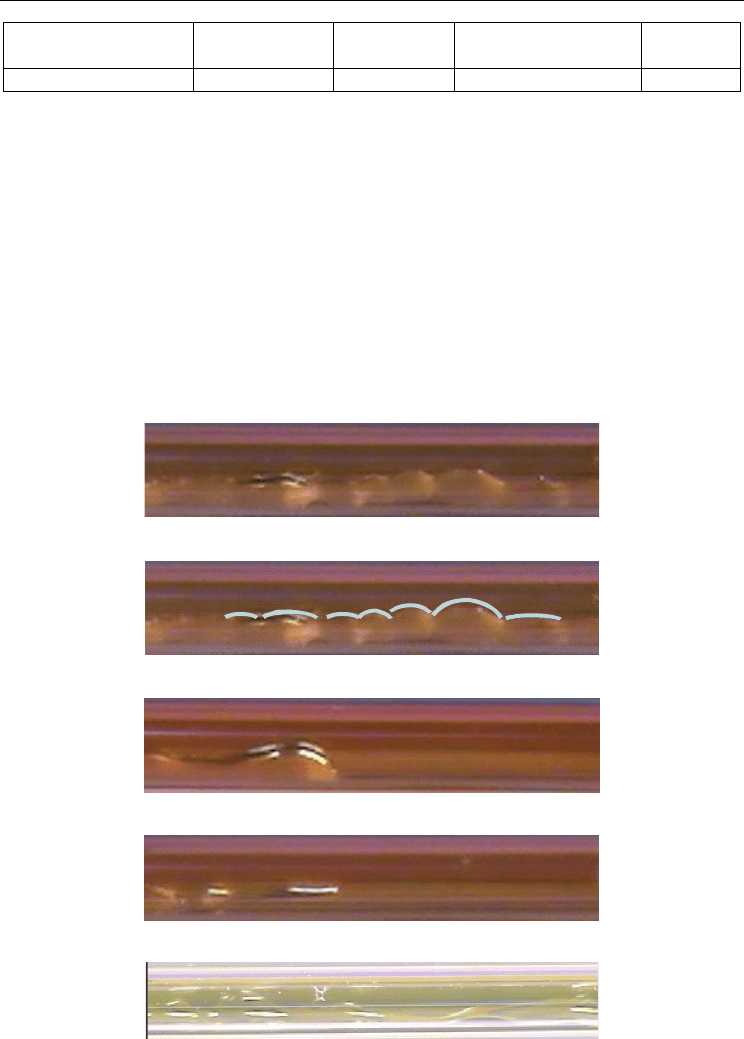
Evaporation, Condensation and Heat Transfer
472
Inner diameter D
in
(mm)
Mass flow rate
(kg/s)
Mass flux
(kg/m
2
s)
Imposed heat flux
(W/m
2
)
Re
1.0 1.7 × 10
−6
2.2 3.4 × 10
6
2.1
Table 1. Experimental conditions.
Figures 9(a1), (a2), (b) and (c) show images of the liquid behaviour near the dry-out position.
Figures 10(a1), (a2), (b) and (c) show images from other experimental runs. In Figs. 9(a2) and
10(a2), curves are drawn to indicate the liquid–vapour interface because the position of the
interface was somewhat difficult to see owing to the image quality. The dry-out position
was approximately 240 mm away from the inlet, as estimated by a simple heat balance
estimation. The dry-out phenomenon was in fact observed near this position. Figures 9(b)
and 10(b) show results for pure water, and Figs. 9(c) and 10(c) show those for the ethanol
aqueous solution. Figures 9(a1), 9(a2), 10(a1) and 10(a2) show that the butanol aqueous
solution exhibited very peculiar liquid behaviour. The liquid film was elongated in the
outlet direction, squeezed and separated into several smaller drops, and then it disappeared
by vaporisation. This pattern of phenomena was sometimes repeated. In contrast, pure
water and the ethanol aqueous solution did not exhibit such movement; they simply formed
a relatively larger drop and disappeared by vaporisation.
Fig. 9.1a. Liquid behaviour of the butanol aqueous solution (7.15 wt%) (Run 1a).
Fig. 9.2a. Liquid behaviour of the butanol aqueous solution (7.15 wt%) (Run 1a).
Fig. 9b. Liquid behaviour of pure water (Run 1b).
Fig. 9c. Liquid behaviour of the ethanol aqueous solution (7.15 wt%) (Run 1c).
Fig. 10.1a. Liquid behaviour of the butanol aqueous solution (7.15 wt%) (Run 2a).
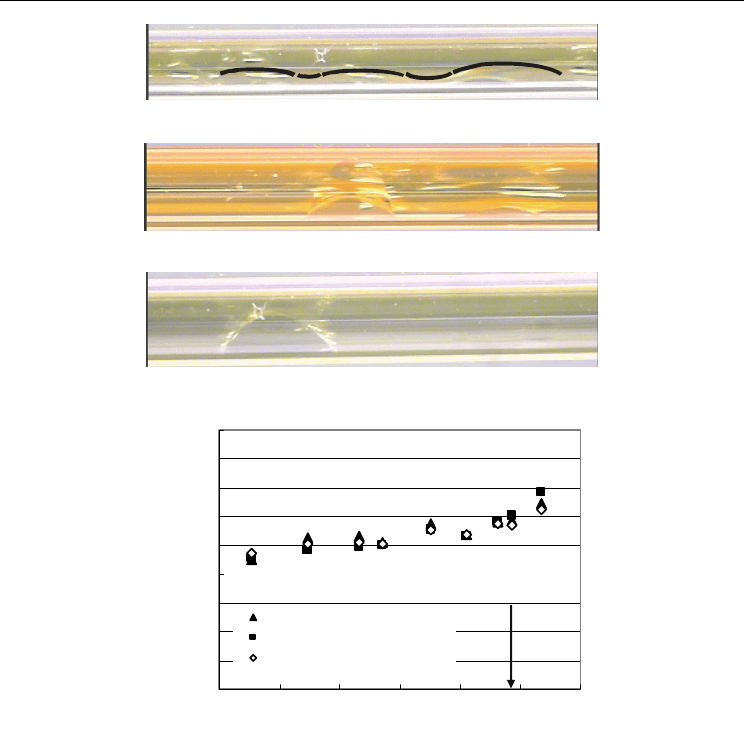
High-Carbon Alcohol Aqueous Solutions and
Their Application to Flow Boiling in Various Mini-Tube Systems
473
Fig. 10.2a. Liquid behaviour of the butanol aqueous solution (7.15 wt%) (Run 2a).
Fig. 10b. Liquid behaviour of pure water (Run 2b).
Fig. 10c. Liquid behaviour of the ethanol aqueous solution (7.15 wt%) (Run 2c).
0.0
20.0
40.0
60.0
80.0
100.0
120.0
140.0
160.0
180.0
0 0.05 0.1 0.15 0.2 0.25 0.3
Distance from the inlet-side electrode[m]
Temperature[
℃
]
Butanol aqueous solution(7.15wt%)
Ethanol aqueous solution(7.15wt%)
Pure water
Dryout point
Fig. 11. Time-averaged temperature distribution at the tube surface (D
in
= 1 mm).
The distribution of the time-averaged temperature at the outer surface of the tube is
shown in Fig. 11. The position of the dry-out point, indicated in the figure, was estimated
by a simple heat balance calculation ignoring surface tension phenomena. Observation
results indicated that the estimated position was reasonable. On the basis of Fig. 11, the
authors thought that under these experimental conditions, the butanol aqueous solution
exhibited no apparent difference from pure water and the ethanol solution in terms of
heat transfer. The butanol solution did exhibit peculiar movement of the evaporating
liquid layer but the time-averaged dry-out position was not delayed. One reason for this
could be the time span between the film elongation, shown in Fig. 9(a1), and the dry-out
phenomenon for the butanol solution. The butanol solution exhibited a longer time span
than pure water and the ethanol solution, and consequently, a larger temperature
fluctuation. Therefore, even if the film elongation delayed the dry out, the longer dry-out
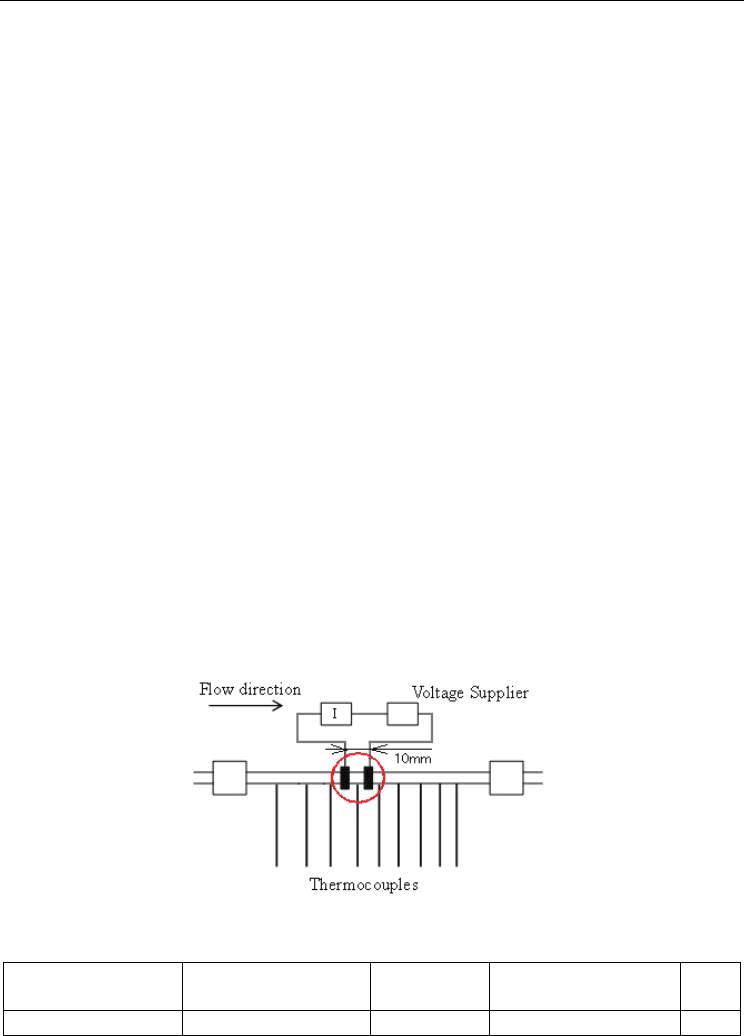
Evaporation, Condensation and Heat Transfer
474
time span cancelled any advantage. Another reason could be the system design. In this
simple straight tube, the temperature gradient in the longitudinal direction can not be
increased much. The thermocapillary effect is generally enhanced by a larger temperature
gradient. Thus, heating area should be localized, i.e. it should cover only a small area of
the tube.
Next, the authors attempted an experiment in which the heated area was limited to only 10
mm in the longitudinal direction. It was assumed that the liquid would experience a higher
temperature gradient at the region where the flow enters the small heated area. Figure 12
shows the test section used for this experiment. The length of the heated area differs from
that in Fig. 8(b). The tube was the same quartz tube coated with the same mixture of ITO
and silver; its ID was 1 mm and OD was 2 mm. An electrodes was set at each end of the
heated length. As in the experiment in Fig. 8(b), nine thermocouples were glued to the outer
surface of the tube. Table 2 lists experimental conditions and Table 3 lists specifications of
test fluids.
The temperature of the outer surface at the midpoint of the heated region was measured to
determine the cooling ability of the working fluid when a constant power of 3.5 W was
applied to the heated area. The temperature was averaged from data taken over 30 min and
is plotted in Figs. 13(a) and 13(b). Figure 13(b) shows an enlarged plot of the heated area.
The temperature of the heated area was very high because the area became almost perfectly
dry in the process. As shown in Fig. 13(b), the temperature of the butanol and pentanol
aqueous solutions, which are nonlinear solutions, was approximately 70° lower than that of
pure water. The temperature of the ethanol solution was also lower than that of pure water
but the temperature difference was approximately 35°, and the cooling effect was weaker
than that for butanol and pentanol solutions. The hexanol aqueous solution showed a
weaker cooling effect than the ethanol solution although the hexanol solution is categorized
as nonlinear. This contradiction requires further investigation. The authors think that it
could be related to the high viscosity of the hexanol solution.
Fig. 12. Test section with the short heating length of D
in
= 1 mm.
Inner diameter D
in
(mm)
Mass flow rate
(kg/s)
Mass flux
(kg/m
2
s)
Imposed heat flux
(W/m
2
)
Re
1.0 2.8 × 10
−6
3.6 1.1 × 10
5
12
Table 2. Experimental conditions (short heating length experiment).
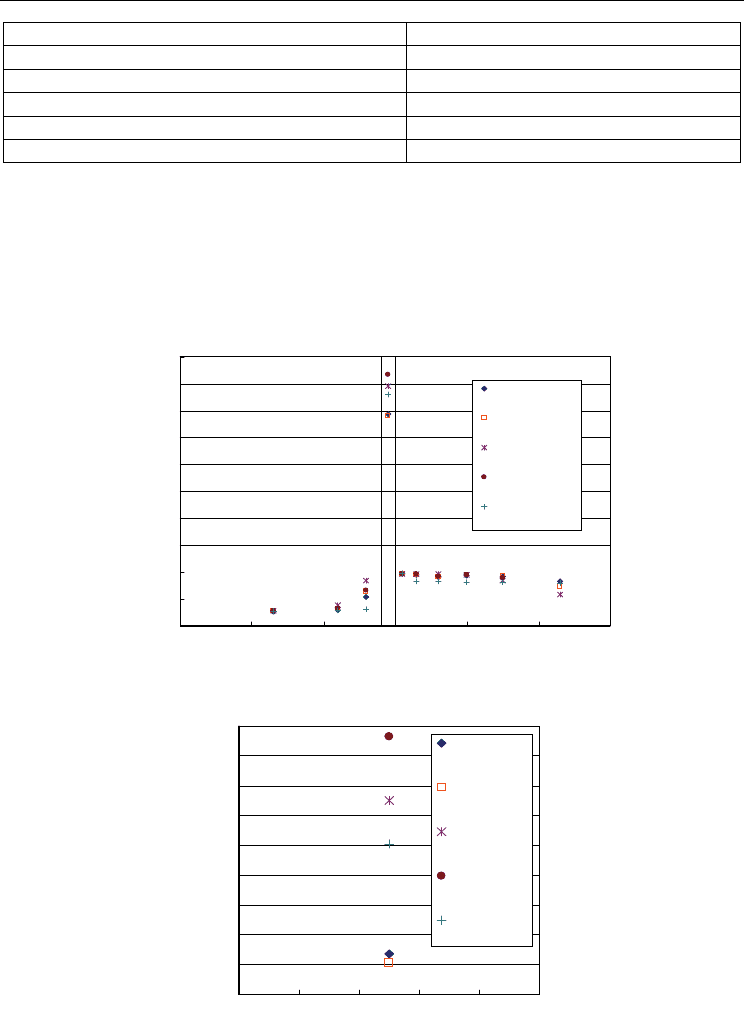
High-Carbon Alcohol Aqueous Solutions and
Their Application to Flow Boiling in Various Mini-Tube Systems
475
Fluid Concentration (wt%)
Butanol aq. sol. 7.15
Pentanol aq. sol. 2.0
Hexanol aq. sol. 0.58
Pure water -
Ethanol aq. sol. 55
Table 3. Test fluids (short heating length experiment).
When the heating length was as large as 300 mm, as shown in Fig. 8(b), the solution
switched to the vapour phase in a complicated manner through the entire length of the
heated region. However, in the experiment with the very short heated region shown in Fig.
12, the solution quickly changed to a liquid layer and then to vapour near the entrance to the
heated region. This made the observation rather simple and the dry out was readily
detected.
0
50
100
150
200
250
300
350
400
450
500
0 50 100 150 200 250 300
Distance from the inlet-side electrode[m m ]
T e m p e rtu re [℃]
B utanol A q .
Sol. (7 .15w t%)
P entanol A q .
Sol. (2 w t% )
H exanol A q .
Sol. (0 .58w t%)
P ure w ater
Ethanol A q .
Sol. (55w t%)
Fig. 13a. Distribution of temperature at the outer surface of the tube.
380
390
400
410
420
430
440
450
460
470
140 142 144 146 148 150
H eating section[m m ]
T e m p e rtu re [℃ ]
B utanol A q .
Sol.
(7 .15w t%)
P entanol A q .
Sol. (2 w t% )
H exanol A q .
Sol.
(0 .58w t%)
P ure w ater
Ethanol A q .
Sol. (55w t%)
Fig. 13b. Distribution of temperature at the outer surface of the heated section.
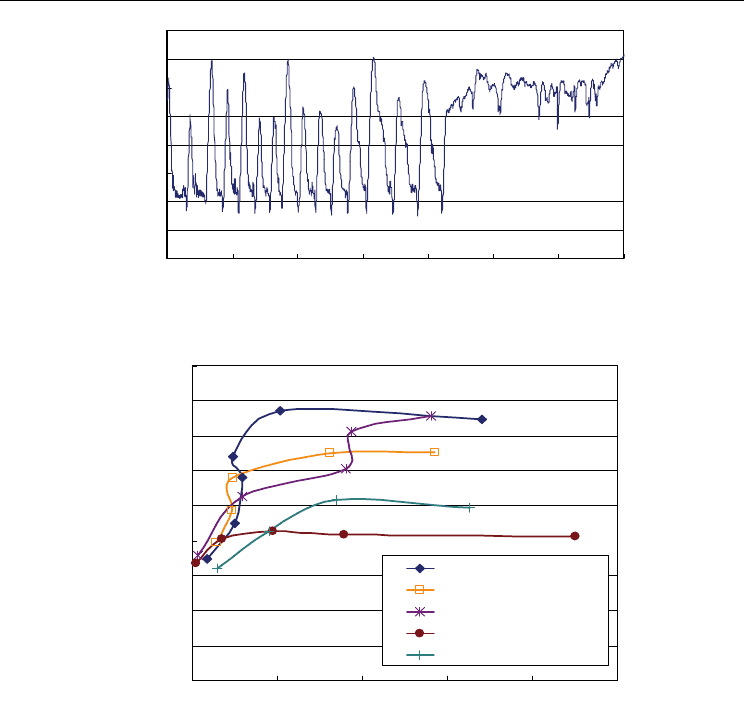
Evaporation, Condensation and Heat Transfer
476
0
50
100
150
200
250
300
350
400
0 100 200 300 400 500 600 700
Time[s]
Tem perature[℃]
Fig. 14. Temperature fluctuation at the outer surface (butanol aqueous solution).
0.0E+00
1.0E+04
2.0E+04
3.0E+04
4.0E+04
5.0E+04
6.0E+04
7.0E+04
8.0E+04
9.0E+04
0 50 100 150 200 250
⊿Tsat[℃]
heat flux[W /m
2
]
B utanol A q .Sol.(7 .15w t%)
P entanol A q .Sol.(2 .0w t%)
H exanol A q .Sol.(0 .58w t%)
Pure water
Ethanol A q .Sol.(5 5 .0w t%)
Fig. 15. Boiling curves of all test fluids.
The authors investigated the onset of the dry out state by gradually increasing the applied
power. Figure 14 shows the temperature fluctuation before and after the onset of the dry out
for the butanol aqueous solution. Before the perfect dry out occurred, the temperature
fluctuated strongly. When the liquid layer evaporated, the temperature rapidly increased;
however, once the liquid further entered the heated region, the temperature quickly
decreased to a value approximately equal to the saturated temperature. However, when the
power increased, the liquid could no longer remain in the heated area and it evaporated as
soon as it entered the region. At this point, the temperature became extremely high, and the
inner surface of the tube became perfectly dry.
This dry-out pattern was very unusual because the flow rate was quite small and the
temperature of the dried wall was extremely high in this study. Thus, the detected dry-out
heat flux might not be readily comparable to the heat flux of conventional dry-out
phenomena, which should be noted when referring to other researchers’ data.

High-Carbon Alcohol Aqueous Solutions and
Their Application to Flow Boiling in Various Mini-Tube Systems
477
The authors investigated the heat flux at the unusual dry-out point described above by
changing the type of fluid. Figure 15 shows boiling curves obtained in those experiments.
The heat flux was corrected by reducing the heat loss to environmental air and to the
surrounding quartz region by heat conduction. The heat loss was estimated by performing a
preliminary experiment without flowing liquid whose details are omitted here. Note that
the heat flux was very small because the flow rate was quite small in these experiments. As
shown in Fig. 15, maximum heat fluxes obtainable with nonlinear solutions, namely the
butanol and pentanol aqueous solutions, were larger than those of other fluids. The authors
considered that those nonlinear solutions tended to wet the heated surface more than other
fluids owing to their peculiar characteristics, and that the dry-out state was delayed as a
result. This difference was made clear by adopting a short heating region. The large
temperature gradient that was realized near the entrance of the heated area could have
intensified the nonlinear thermocapillary effect.
In summary, the authors attempted a very special type of a situation for applying a very
large temperature gradient to a liquid layer of a nonlinear solution and succeeded in
obtaining more desirable characteristics of the solution. However, under this condition, the
heat flux at the dry-out point was too small for application in practical methods. Therefore,
further ideas and modifications, including changes to the flow pattern and heating system,
are needed to obtain a practical level of the heat flux. The authors began modifying the
experimental setup after experiments shown in Section 3.
4. Modified application to flow boiling in T-junction mini tube
In the previous section, the butanol aqueous solution was found to exhibit better heat
transfer characteristics as long as it experienced a large temperature gradient over a short
heating region. However, in previous experiments, the obtained heat flux was very small
and was not in the range of practical application. As a more practical experiment, the
authors set up new test sections of T-junction mini channels. In this flow pattern, the fluid
could impinge on the heated surface and flow away with boiling bubbles to the outlet.
Therefore, the temperature boundary layer can be thinned, and also, as shown in Fig. 16, the
temperature gradient around the boiling bubble located on the heated surface can be
increased. The thermocapillary effect is expected to work more strongly under this
temperature gradient.
Fig. 16. Impinging flow pattern with boiling when using a nonlinear solution.
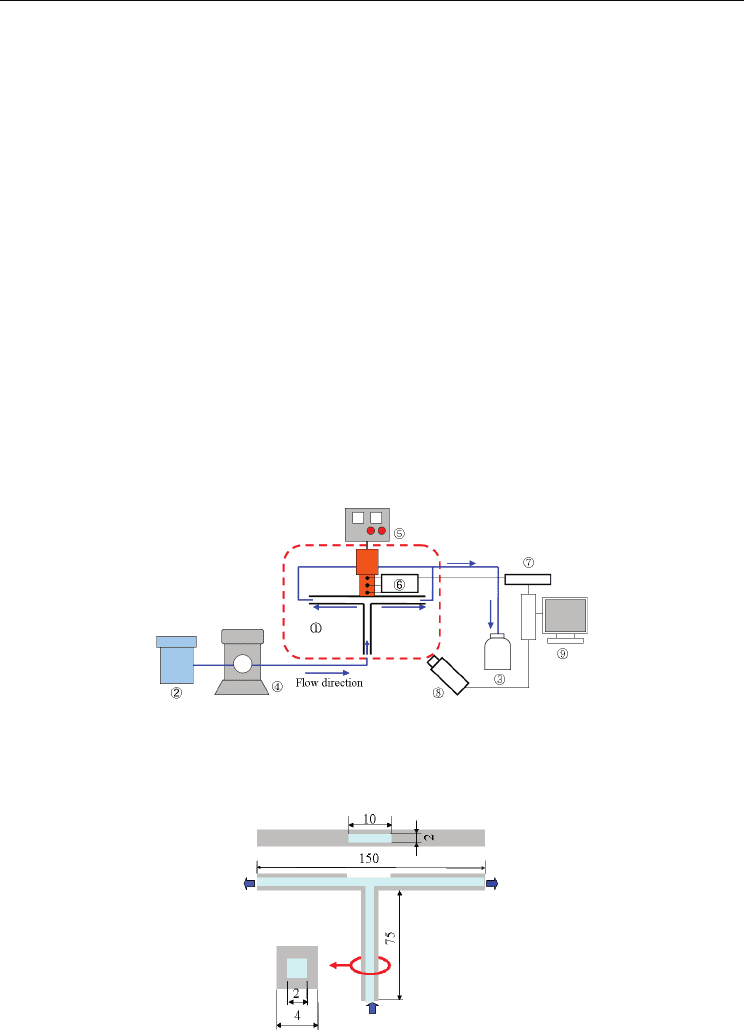
Evaporation, Condensation and Heat Transfer
478
Here the authors attempted two types of test sections. One is a T-junction mini tube made of
transparent quartz for observation, and the other is a T-junction made of insulating polymer
material for localizing heat transfer at the heated surface to obtain precise heat flux values.
4.1 T-junction mini tube made of quartz glass
A schematic of the flow system is shown in Fig. 17. The T-junction channel was made of
quartz glass. The heated surface was the edge of a copper block that contained a rod heater
inside. DC power was applied to the rod heater. Figure 18 shows details of the T-junction
test section. The inside cross-sectional area of the channel was 2 mm × 2 mm and outer
dimensions of the cross section were 4 mm × 4 mm. The entire length was 150 mm. At the
middle of the upper surface of the horizontal channel, a slit of a cross-sectional area of 2 mm
× 10 mm was prepared for inserting the edge of the copper block. A vertical channel of 75
mm was added to form a T-junction channel. The geometry of the copper block is shown in
Fig. 19. The fluid contacted the left edge. The surface was polished by using #3000 emery
paper. Three K-type thermocouples were inserted near the edge of the copper block. The
thermocouples were located 3 mm, 7 mm and 11 mm from the contacting surface,
respectively. The temperature gradient and heat flux were deduced from the obtained
temperature data by applying the simple one-dimensional Fourier law. The surface
temperature at the edge was also calculated by extrapolation from the data. The motion of
the liquid and boiling bubbles was observed by using a video camera. Experimental
conditions are shown in Table 4. Test fluids were butanol aqueous solutions of 3.00 wt% and
7.15 wt% and pure water.
1: Test section; 2, 3: Tank; 4: Metering pump; 5: DC power supply; 6: Thermocouples; 7: Thermocouple
logger; 8: Video camera and 9: PC
Fig. 17. Experimental apparatus (T-junction mini tube made of quartz glass).
Fig. 18. Test section (T-junction mini tube made of quartz glass).
